Advertisement
Some good advice about the carry-on luggage you should never leave the dock without.

If you end up sitting on an overturned hull, your ditch bag could become a lifesaver. These two boaters in Englewood, Florida, were rescued by the U.S. Coast Guard cutter Diamondback. (Photo: U.S. Coast Guard)
Whether you're an inshore daycruiser, an offshore angler, or a cruising sailor, you always need to be prepared to abandon ship. True, thanks to modern boatbuilding techniques, U.S. Coast Guard regulations, and that omnipresent yet underappreciated flotation added throughout today's small boats, sinkings are less common than they used to be. But they do still happen. And more often, modern boats swamp and/ or capsize. Fires can also create the need to abandon ship. In events like these, it's imperative that you have the basic gear for survival close at hand. You need a ditch bag.
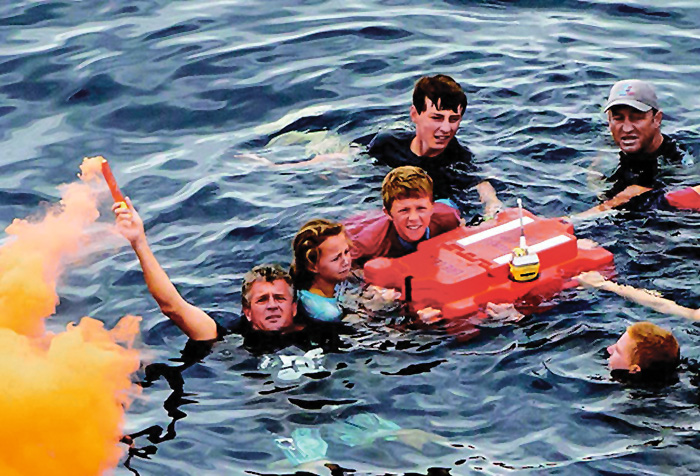
Life Cell is a buoyant ditch kit that has room for important supplies, including an EPIRB.
The Basics
First, remember that even though you're only going close inshore for a fishing trip, an accident may leave you drifting for many days out at sea. Even boating in an inland tributary can result in unexpected drifting for long distances and time periods. The more contingencies you're prepared for, the better.
Obviously, we can't discuss every conceivable situation, and you should consider items in addition to those listed below. But here are a few helpful suggestions. We'll break out recreational mariners into two basic categories: inshore boaters who spend their time relatively close to shore, usually returning to the dock before nightfall; and offshore boaters who make longer voyages, often outside sight of land.
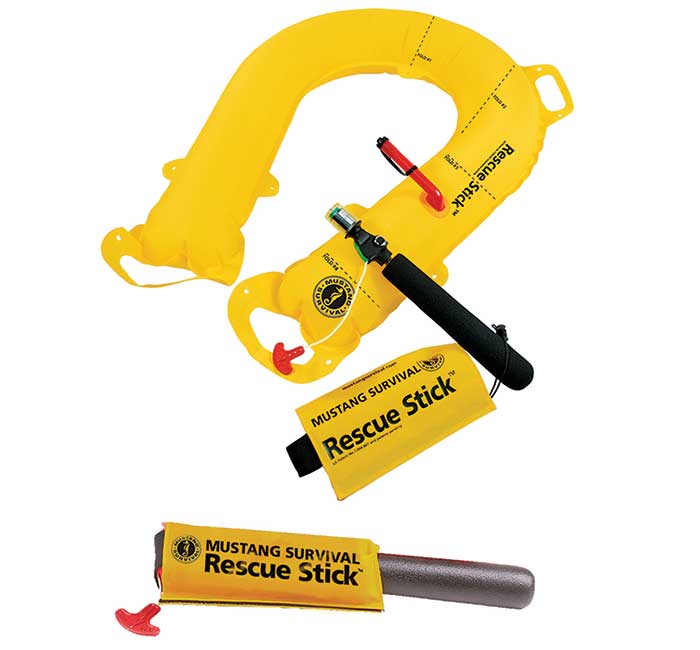
A compact, easy-to-pack inflatable like the Mustang Rescue Stick can add significant flotation to your ditch bag.
Regardless of where you do your boating and what sort of boat you own, there are a few key items to keep in mind about a ditch bag. First, it needs to be readily accessible. The life-saving items inside it can't save your life if they're buried deep in a stowage compartment. Secondly, the bag itself needs to be both water-resistant (preferably waterproof) and buoyant to protect the gear inside. Either rigid or soft-sided cases can do the job, just as long as they meet these basic requirements. The ditch bag should also be bright and easy to spot, so you don't lose it if you become separated from it while entering or in the water. Reflective tape or patches are a plus, and may also aid as a visual cue to search and rescue personnel.
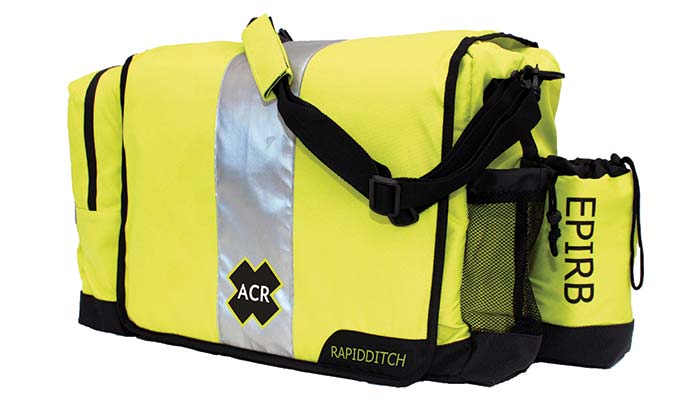
A high-quality ditch bag, like this ACR RapidDitch, is sturdy, has a bright exterior with reflective surfaces, includes built-in flotation (25 pounds worth, in this case), and is water-resistant.
Another important factor is that you have it with you when you go boating. Don't pack a ditch bag, put it on your boat, and leave it there, unless you never go out on anyone else's boat. This is because you may not know what sort of preparation the owner or captain of another boat has made.
The Belongings
Just what, exactly, belongs in your ditch bag? That depends, to some degree, on the type of boater you are and your needs. There are a few basic items that belong in your ditch bag no matter which category you fall into, and these fulfill many of the inland boater's needs while essentially serving as the basic building block for the other category.
Note the use of the word "basic." One of the keys to packing a ditch bag and bringing it with you whenever you get onto a boat is keeping it light and compact. While it would be nice to include everything from a wet suit to a chicken dinner, reality dictates that we keep our gear to a necessary minimum.
Inshore Boaters
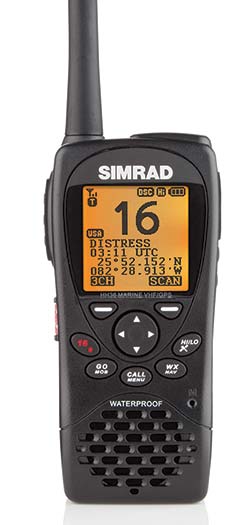
Many modern handheld VHFs have GPS
built in, providing DSC capability.
- Handheld waterproof VHF radio. Smart boaters will opt for one that includes a built-in GPS, so it has Digital Selective Calling (DSC) functionality. And make sure you remove the unit from your ditch bag at least once a month and top off the battery with a fresh charge or better still, carry spare off-the-shelf batteries.
- Handheld GPS. If your VHF doesn't have GPS built in. Raising someone on the radio won't do you much good if you can't tell them exactly where you are.
- Visual signaling devices for both daylight and night. A signal mirror, a red or yellow streamer you can deploy in the water, flares, and waterproof strobe light are all appropriate. A new option that acts as all of the above (and meets Coast Guard requirements for pyrotechnic flares) is the Weems & Plath Electronic Flare, a battery-powered LED SOS Distress Light that floats, is waterproof, lasts up to 60 hours, and never expires. It includes a day signal flag. Having all of the above is better.
- Audible signaling device. A simple Coast Guard-approved whistle is usually best. Air horns can lose their charge over time, and cans may rust. But a whistle is a fail-safe signaling device.
- Electronic signaling device. An EPIRB or at least a PLB can be amazingly helpful, bringing rescue to your spot in a very short time. These are more expensive than other satellite messengers, but if the sharks are circling, you'll be glad you spent the money.
- Some form of flotation. If a life jacket isn't worn at all times on your boat. In some cases, you can purchase a ditch bag that has integrated flotation (though this will naturally increase its size). If you need to add flotation, due to size and weight constraints, an inflatable device like the Mustang Rescue Stick is good. But we recommend wearing a life jacket in the first place.
- Water packaged in a strong pouch or container. The word "strong" is key here. Thin pouches and plastic bottles can leak or become punctured over time, and saturate the contents of your ditch bag. Have an air bubble in the container sufficient to float it.
- Basic first-aid kit.
- Sunscreen. SPF 30 or higher.
If you have a life raft that isn't prepacked with this gear:
- Bailer and/or sponge. To remove water.
- Mylar "space" blanket Patch kit.
- Prepackaged foods. Prepackaged foods with a distant expiration date, such as energy bars or freeze-dried "emergency" food.
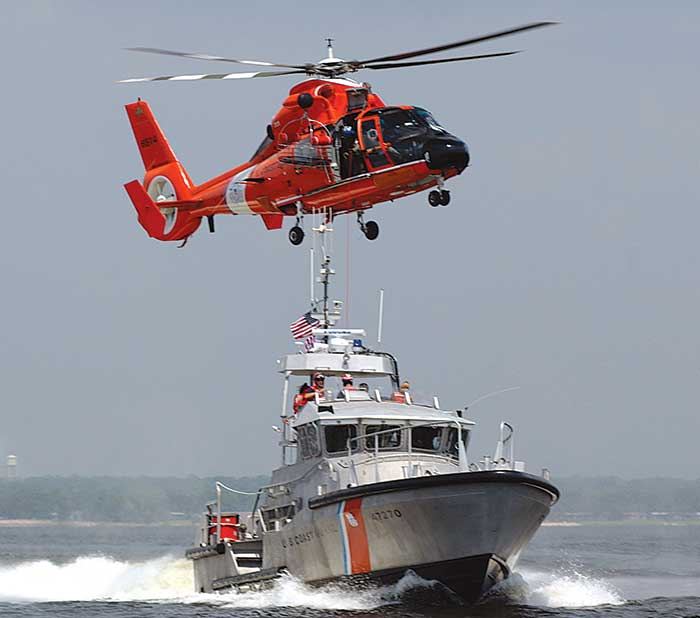
The cavalry is coming — and if you have a good ditch bag to help survive an abandon-ship situation, you have a much better chance of greeting them. (Photo: U.S. Coast Guard)
Offshore Boaters
Everything in the inshore boater's bag, plus:
- Satellite phone. Encased in a secondary water-tight enclosure
- Additional water and food.
If you have a life raft isn't prepacked with this gear:
- Basic fishing kit. With a handline, hooks, a couple of lures, and sinkers
- Knife. Find one with a blunt tip (so you don't puncture your life raft) and one with a point
- Length of rope. For securing flotsam or tying off to an overturned boat
- Waterproof flashlight and a pack of chem light sticks
Additional Items
You may want to include a spare pair of prescription glasses and/or sunglasses, and prescription medications, as well as any other personal gear you may need to survive for a time in the water. Other items to take if appropriate: matches or lighter, multi-tool, cutting board, sharpening stone, gaff, survival watermaker, seasick pills, toilet paper, duct tape, spare air pump if you use an inflatable, zippered plastic bags, wool or poly cap and gloves, sponge, watch, compass, and cash.
Should you pack your own ditch bag, or purchase a factory-packed version? That depends on your specific needs and how well any specific pre-prepped bag fits them. But one thing is for sure: If you keep a good ditch bag prepped, ready, and within easy reach, your chances of survival are far better if you ever have to abandon ship.
